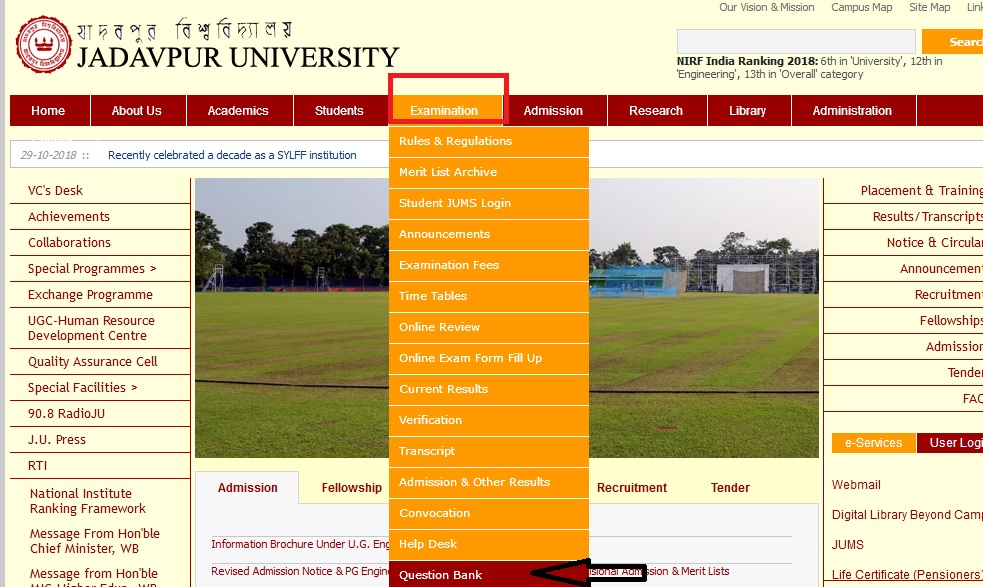Comparative Printing Theories B.E Question Paper : jaduniv.edu.in
Name of the University : Jadavpur University
Department : Printing Engineering
Degree : B.E
Subject Code/Name : Comparative Printing Theories
Year/Sem : IV/II
Website : jaduniv.edu.in
Document Type : Model Question Paper
Download Model/Sample Question Paper : https://www.pdfquestion.in/uploads/dspace.jdvu.ac.in/5421-COMPARATIVE_PRINTING_THEORIES_Seme1_2006.pdf
Jadavpur Comparative Printing Theories Question Paper
B. Print. Engg. Final Examination 2006 :
1st Semester :
Comparative Printing Theories :
Time : Three hours
Full Marks : 100
(50 marks for each part)
Use a separate Answer-Script for each part. :
Related : Building Management & Maintenance B.Arch Question Paper : www.pdfquestion.in/6715.html
Model Questions
PART-I
Answer Question No. 1 any one from the rest. :
1. Answer any five : 5×6=30
a) Why ink-makers supply much higher viscosity inks than that used in flexographic and gravure printing press ?
b) Which type of viscometer is convenient to ink manufacturer’s requirement and why ?
c) Mention the characteristics of dilatant substances with its rheological equation.

d) What kind of rheological material would ink having a high proportion of pigment be ? State its rheological equation and rheogram.
e) Mention the rheological characteristics of thixotropic substances. What do you mean by ‘false-bodied material’ ?
f) Differentiate between capillary viscometer and rotational viscometer.
g) Deduce the rheological equation for a viscoelastic substance.
2. a) State the principle of co-axial cylindrical viscometer. Deduce the basic functional relationship of it and also mention its various limitations.
b) State the principle of cone and plate type viscometer with neat sketch. How can you determine the flow curve using this principle ? 10+10
3. a) Determine the velocity distribution when a highly pseudo-plastic substance is flowing through a capillary tube and also show the variation of rate of deformation across the tube for the above.
b) What do you mean by normal stress effect of viscoelastic substance ? 16+4
PART-II
Answer Q. 4 and any two of the others. :
4. a) What are the major situations when the offset plate fails to perform in press ? 2 ½
b) Why waterless printing can give higher print contrast than conventional offset ? 2 ½
c) For small offset presses, what are commonly used as plates or masters ? 2 ½
d) What is moire pattern ? 2 ½
5. a) Give the special characteristic features used to identify different printing processes. 7
b) What is registration ? What happens during registration? 6
c) Write about the temperature control system used in driography. 7
6. a) Compare between the following problems :–
(i) Curl and crease
(ii) Picking and Hickies. 5
b) What is security printing ? How are bank cheques printed ? 5
c) Give a comparison between conventional and waterless offset printing. 10
7. a) Give a comparative study between Gravure and silk screen printing. 7
b) What is air-conditioning ? Why is it required in the press ? 6
c) Write a short note on Toroy Waterless printing system. 7
Printing Design
Attempt any five questions. :
1 (a) What are the various types of fits according to Indian standard? Explain them with the help of neat diagrams. 8
(b) What is the significance of preferred number? 3
(c) Define “interchangeability” and discuss its importance. 4
(d) The dimensions of the mating parts according to basic hole system, are given as follows :
Hole : 37.500 mm Shaft : 37.470 mm 37.523 mm 37.445 mm
Find the hole tolerance, shaft tolerance and minimum allowance, maximum allowance. 5
2. (a) What are the advantages and disadvantages of thread joints? 4
(b) What do you understand by the Single Start and double Start thread? 2
(c) Define the following terms with neat sketches.
(i) major diameter (ii) minor diameter
(iii) pitch diameter (iv) pitch
(v) angle of thread (vi) lead. 8
(d) A lever loaded safety valve has a diameter of 100mm. and the blow off pressure is 1.6 N/mm2. The fulcrum of the lever is screwed into the C.I. body of the cover. If the permissible tensile stress is limited to 50 Mpa and the leverage ratio is 8. Find the diameter of the threaded part of the fulcrum and select the size of the bolt. 6
3. (a) How the shaft is designed when it is subjected to twisting moment only? 10
(b) A shaft made of mild steel is required to transmit 100 kw at 300 r.p.m. The supported length of the shaft is 3 metres.
It carries two pulleys each weighing 1500N supported at a distance of 1 metre from the ends respectively. The safe value of stress = 60N/mm2. Draw the load diagram and determine the diameter of the shaft. 10
4. (a) Define the terms load, stress and strain. Discuss the various types of stresses and strain. 6
(b) What is meant by working stress and how it is calculated from the ultimate stress or yield stress of a material? What will be the factor of safety in each case for different types of loading? 6
(c) The piston rod of a steam engine is 50 mm in diameter and 600mm long. The diameter of piston is 400mm. and the maximum steam pressure is 0.9 N/mm2. Find the compression of the piston rod,if the young’s modulus for the material of the piston rod is 210KN/ mm2. 8
5. (a) What is the function of a coupling? What are the requirements of a good coupling? 4
(b) How do you classify couplings? 2